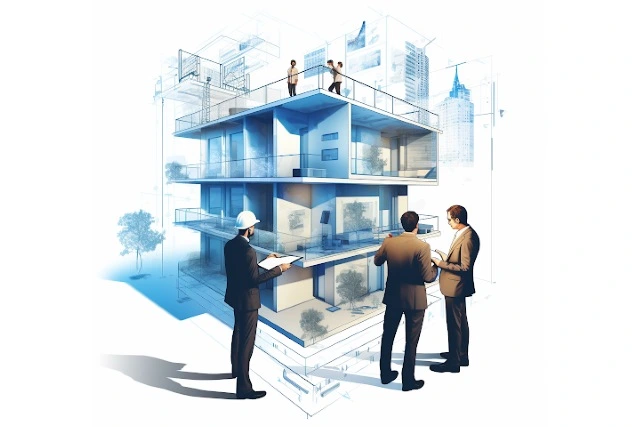For today’s commercial real estate developers and managers, coordinating building information modeling (BIM) and implementing such processes is key to maximizing value across a building’s lifecycle. But what exactly does BIM coordination entail, and what are the specific benefits for commercial projects?
What is BIM?
In the past two decades, BIM, or building information modeling, has soared in popularity and been a game changer in the construction industry. The digital representation of physical and functional characteristics of buildings has not only improved design and visualization but has also enhanced communication among stakeholders.
BIM’s roots can be traced back to the 1970s, when the idea of digital design was still in its infancy. Over the years, as technology advanced, so did BIM, evolving from simple 2D designs to complex 3D models enriched with data.
What does BIM coordination mean?
Building information modeling coordination specifically means ensuring models of a building’s various systems fit together without clashes. This prevents issues before ground is even broken.
BIM isn’t just about 3D models. It encompasses various components, from spatial relationships to light analysis and from geographic information to quantities and properties of building components.
BIM software allows different teams to collaborate through detailed 3D models of the architecture, structure, MEP (mechanical, electrical, and plumbing) systems, etc. By coordinating these models, crews can spot conflicts early and avoid big-time headaches down the road. It’s like an intricate dress rehearsal for construction.
Breaking down its role in construction and key players
In a typical construction project without BIM, issues are often caught in the field once construction is already underway. This leads to expensive change orders and schedule delays. With BIM coordination, these problems can be prevented. Here’s how it works for the key players involved:
- Architects create a 3D architectural model with precise measurements and locations of structural components.
- Engineers create models for building systems like HVAC (heating, ventilation, and air conditioning), plumbing, electrical, etc. They use BIM coordination to ensure that all systems within a building work harmoniously.
- A coordinator then combines these models and runs clash detection software. This reveals issues like ductwork clashing with steel beams.
- The teams collaborate to resolve these clashes before construction begins. Changes are much cheaper at this stage.
- Contractors use the coordinated BIM process for fabrication and field coordination. It means fewer surprises during construction, leading to faster project completion.
Is it hard to implement?
Implementing BIM coordination may require some upfront training and adjustment of traditional workflows. However, the long-term benefits make it worthwhile for most firms. Here are some tips for a successful implementation:
- Senior leadership: Get buy-in from senior leadership and project stakeholders on using BIM processes.
- Training: Train teams on building data software and information modeling standards.
- Pilot program: Start with a pilot project to test workflows before applying to larger projects.
- Acquire consulting: Work with experienced building data consultants if lacking in-house expertise.
- Incorporate into existing workflows: Identify ways to incorporate BIM into existing workflows rather than replacing them completely.
Benefits of a BIM process in commercial real estate
BIM provides numerous advantages for commercial real estate owners long after construction is complete. A detailed 3D model of the building can enhance visualization for marketing and leasing activities. Virtual walkthroughs and rendered models help bring the property to life for potential tenants.
Once the building is operational, the data-rich information model enables streamlined maintenance and facilities management. All the asset information can be linked to specific components in the model, providing instant access to maintenance histories, warranties, spare parts lists, and more. This facilitates smarter building operations.
When it comes time for renovations or retrofits, having the existing building information model speeds up the process and reduces costs. New design changes can be overlaid on the original model, immediately revealing potential clashes and issues. This avoids extensive and costly rework. The model also aids space planning and management, tracking occupancy and vacancies across a portfolio.
Additionally, energy simulation data in BIM helps building owners enhance efficiency and reduce operating expenses. It can also help buildings meet the WELL building standard by simulating the impact of indoor environments on the health and well-being of occupants.
By leveraging BIM through the full lifecycle, commercial developers and managers can maximize returns on investment in their properties. It reduces errors, saves time, and, ultimately, saves money.
How it is revolutionizing the construction business
From safer job sites to better buildings, BIM delivers big benefits for the construction industry:
- Greater cost certainty: Clash detection enables more accurate cost estimates and reduces surprise change orders.
- Faster project timelines: Model-based coordination compresses schedules by resolving issues virtually rather than on-site.
- Higher quality: Construction goes more smoothly using coordinated models, resulting in fewer defects.
- Less waste: Materials can be ordered and fabricated more precisely.
- Improved safety: Project planning and safety analyses can be enhanced.
- More sustainable buildings: Energy usage can be simulated earlier, enabling greener design from the start of a project.
What can we expect from BIM coordination in the future?
Building information modeling continues to evolve and provide more value to the commercial real estate and construction industries. Over the next decade, we expect BIM coordination to expand in the following ways:
- Wider adoption: BIM is gaining momentum and will likely be used on most large commercial projects within 5-10 years.
- Integration with other technologies: It will interface with technologies like IoT sensors, drones, and AR/VR. Using AR glasses (or even smartphones), stakeholders can ‘walk’ through the BIM model superimposed on the real world. With Proptech integration, this experience can include real-time property details.
- Lifecycle data applications: 3D building models will be used not just for design and construction but also for facility management, operation, and maintenance.
- Next-level clash detection: Software will become even better at automatically finding coordination issues in models.
- AI-functionality: AI will expand capabilities even further.
- Interactive dashboards: Dashboards can merge BIM and Proptech data, allowing stakeholders, from architects to real estate agents, to access, analyze, and make decisions based on comprehensive data.
- Mobile/cloud functionality: Coordinating building information modeling will leverage mobile devices and cloud computing for greater accessibility and efficiency.
Coordinating your Proptech today
Proptech mainly deals with the real estate aspect, while BIM focuses on construction. However, the lines between construction and property management are blurring, and the integration of BIM with real estate technology offers an exciting realm of possibilities.
While it’s still an emerging trend, given the myriad of benefits it offers, it’s likely that more and more firms will adopt this integrated approach in the future. Many real estate firms are already incorporating these models into their Proptech platforms.
With the future of building information modeling looking bright, you can get prepared to leverage advancements in BIM by coordinating your Proptech. Bringing your real estate tech solutions into a unified ecosystem enables advanced 3D models to synchronize with your automation systems and smart sensors.
ProptechOS acts as your building operating system to bring these separated solutions into a single platform. Try ProptechOS for free to see how unifying your existing Proptech solutions can help you benefit from BIM technology.

Dr. Erik Wallin
Chief Ecosystem Officer, and founder of ProptechOS and RealEstateCore is recognized as a leader in Building Operating Systems (BOS) and making the buildings of the world smarter. He holds an MSc and a Ph.D. in Media and Computer Science from KTH Royal Institute of Technology.
Read his full bio and information here.

